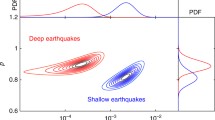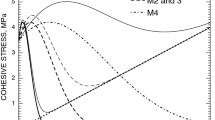Summery
The dilatancy-fluid diffusion (DFD) theory of the seismic mechanism, derived from studies of rock mechanics, describes the geophysical conditions for faulting in terms of two fundamental parameters: deviatoric stress and pore pressure. The latter allowed the time variable to be included, through a diffusive equation, in the theory of the seismic mechanism. The stress field in proximity of a slipped fault surface is here considered in some detail and its influence on dilatancy and fluid pressure is exploited in order to test the capability of the DFD theory of explaining the evolution in time and space of aftershock phenomena.
Riassunto
La teoria della dilatanza-diffusione fluida (DFD) del meccanismo sismico, ottenuta da studi di meccanica delle rocce, descrive le condizioni geofisiche per la creazione di una faglia attiva in termini di due parametri fondamentali: lo sforzo deviatorico e la pressione nei pori dovuta al fluido. Quest'ultima ha permesso di inserire, attraverso l'equazione di diffusione, il tempo come variabile nella teoria del meccanismo sismico. Si considera qui in dettaglio il campo di sforzo in prossimità della faglia dopo che si è verificato lo scivolamento, e la sua influenza sulla dilatanza e sulla pressione del fluido è analizzata per verificare la capacità della teoria DFD di spiegare l'evoluzione spazio-temporale degli aftershock.
Similar content being viewed by others
References
A. Nur:Bull. Seismol. Soc. Am.,62, 1217 (1972).
J. H. Whitcomb, J. D. Garmany andD. L. Anderson:Science,180, 632 (1973).
Y. P. Aggarwal, L. R. Sykes, J. Ambruster andM. L. Sbar:Nature (London),241, 101 (1973).
H. Benioff:Bull. Seismol. Soc. Am.,41, 31 (1951).
A. Nur andJ. R. Booker:Science,175, 885 (1972).
J. Weertman:J. Geophys. Res.,79, 3291 (1974).
C. Richter:Elementary Seismology (San Francisco, Cal., 1958).
See,e.g.,J. C. Jaeger andN. G. W. Cook:Fundamentals of Rock Mechanics, 2nd edition (London, 1976).
W. F. Brace, B. W. Paulding andC.H. Scholz:J. Geophys. Res.,71, 3939 (1966)
B. T. Brady:Pure Appl. Geophys.,112, 701 (1974).
C. H. Scholz andR. Kranz:J. Geophys. Res.,79, 2132 (1974).
K. Hadley:Pure Appl. Geophys.,113, 1 (1975).
F. C. Frank:Rev. Geophys.,3, 485 (1965).
See,e.g.,G. R. Irwin:Structural Mechanics (New York, N. Y., 1958).
B. R. Lawn andT. R. Wilshaw:Fracture of Brittle Solids (London, 1975).
F. Gilbert:Geophys. J. R. Astron. Soc.,22, 223 (1971).
C. G. Dahm:Bull. Seismol. Soc. Am.,26, 1 (1936).
K. E. Bullen:N. Z. J. Geol. Geophys.,19, 497 (1938).
J. Henderson:N. Z. J. Geol. Geophys.,24, 195 (1943).
H. Benioff:Bull. Seismol. Soc. Am.,28, 77 (1938).
H. O. Wood:Bull. Seismol. Soc., Am.,23, 43 (1933).
R. Console, F. Peronaci andA. Sonaglia:Ann. Geofis.,26, Supplemento (1973) (in Italian).
E.M.S.C. (European Mediterranean Seismology Center):Boll. Geofis. Teor. Appl.,19, 581 (1976).
I. Finetti, F. Giorgetti, H. Haessler, T. P. Hoang, D. Slejko andD. Wittingler:Boll. Geofis. Teor. Appl.,19, 637 (1976).
M. Caputo:Ann. Geofis.,29, 171 (1976).
M. Wyss andJ. N. Brune:J. Geophys. Res.,73, 4681 (1968).
Author information
Authors and Affiliations
Rights and permissions
About this article
Cite this article
Bonafede, M., Mulargia, F. & Boschi, E. Implications of the dilatancy-fluid diffusion theory for aftershock sequences. Il Nuovo Cimento C 3, 180–190 (1980). https://doi.org/10.1007/BF02507143
Received:
Issue Date:
DOI: https://doi.org/10.1007/BF02507143




